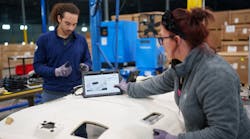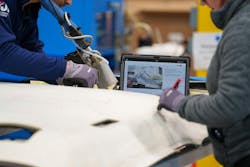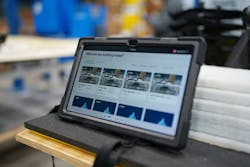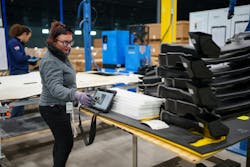Manufacturing Execution Systems Create Quality Employees
Maurice Stallard, director of manufacturing and engineering at HJI Supply Chain Solutions, wasn’t thinking about short-term production gains when he assessed manufacturing execution systems (MES) options for the company. Stallard wanted a long-term training aid and software foisted on him wasn’t up to the task.
HJI began as a trucking company and expanded into fulfillment, kitting and sequencing for tier 1 and tier 2 automotive manufacturers. The company’s first foray into manufacturing began several years ago, assembling seats for an automotive manufacturer. HJI owns the facility, but the customer insisted HJI use its MES.
Stallard’s background as a frontline supervisor, maintenance team leader, and continuous improvement and operations manager for companies like Keurig Dr. Pepper and GE Appliances among others, taught him that operators make mistakes when they don’t have clear instructions or encounter the unexpected.
An MES should address these concerns. The software HJI had to use to get a book of business didn’t. That’s how Stallard considered his options when he started fresh start with a new MES.
PICO MES at the IndustryWeek Operations Leadership Summit
Ryan Kuhlenbeck, CEO and co-founder of PICO MES, the technology provider mentioned in this story, will speak at IW's live event on Friday, June 28, in Indianapolis. Kuhlenbeck will partner with automotive supplier MORyde's process improvement engineer Greg Whitt to discuss digital assembly systems for error proofing.
Held from June 26-June 28, the IndustryWeek Operations Leadership Summit gathers manufacturing leaders to discuss operations: The crucial task of getting more goods out of a plant safely, cost effectively and with high quality.
Needs (to Use Lesser Software) Must
The customer’s MES provided a big picture-view of assembly steps but skipped the details. It suffered from low picture quality and didn’t leave space to explain why a particular assembly step was necessary or what critical aspects of a step the operator should focus on. It could not track individual performance to detect employees that excelled at certain functions but struggled at others.
Operators bypassed order of assembly directions rather than reporting to their line supervisors the system glitches that could occur five or six times per shift. The software lacked failsafe options to prevent workarounds that workers use to maintain high production rates.
All of these shortcomings provided multiple opportunities for process errors and prevented HJI from using the MES as a training tool. Stallard recommended to the customer switching to software developed by Pico MES, that HJI had assessed for deployment at another plant.
“They didn't really have the appetite for that improvement…[but] we knew we had that option in our back pocket. And then when [a new] opportunity came about, we said now’s the time,” Stallard says.
Consistency Earns Customer Confidence
After winning a bid to assemble headliners (the material that covers the ceiling of a vehicle) for Toyota, HJI installed the new MES prior to Toyota’s plant walkthrough to demonstrate HJI’s ability to provide consistency and quality.
Operators view assembly instructions on tablets and advance the instructions after completing steps. For example, after applying glue, the operator must hold a part in place for a specific amount of time to ensure adhesion. A timer on the MES indicates how long the operator must hold the part in place. The worker can’t advance the assembly instructions until the timer runs out.
The MES tracks the duration of each step in the manufacturing process to calculate cycle times. Line supervisors review the captured data.
“We tend to take about 18-to-26 minutes to produce a headliner. If I see we’re over cycle and running our averages around 27 minutes, I can [check the data] and see if we are running over cycle in general or [just] running the high-cycle-time parts. … I can also even break it down and look at each individual step within the process to see where we are seeing hiccups or difficulties,” Stallard says.
Operators use the tablets’ cameras to take pictures of the final product and the image links to the assembly record. HJI can investigate errors and figure out where processes break down if quality drops.
HJI’s contract grew from assembling all headliners for variations of a single vehicle to five different vehicles with two more launching in the middle of this year. Stallard lays gaining the new business in part on inspiring the client’s confidence by adopting and effectively deploying the MES.
Adaptable MES = Adaptable Operators
Manufacturers need to understand the parameters that define one MES from another to determine what fits their needs.
Stallard is less interested in a MES’ ability to provide initial training and more concerned about the system’s value as a sustainable training tool. Adaptable design, such as ease of adding media and expanding written directions allow the software to grow and cover all eventualities, lessens the load on supervisors.
In Stallard’s experience, operators commit errors when they encounter a part or SKU the manufacturer doesn’t often run. Operators make best guesses on how to handle unexpected situations. An adaptable MES allows the manufacturer to continue adding process steps into the software to cover a larger range of eventualities.
“You can build in those steps within the process where they’re always at the operator’s point of use. Instead of relying on that operator to stop what they’re doing and seek someone to get the correct answers, the answers are there in front of them. They’re more likely to, instead of guessing, follow the right steps,” says Stallard.
Adding “the why behind the what” for specific directions explains why one process step is critical to further steps, sharpening the operator’s attention when needed. Easily added videos explain particular, tricky situations.
If adding video is very easy, operators can ask manufacturers to re-shoot and re-upload how-to videos to best reflect operator experience. The MES becomes a collaborative tool, not just software foisted on the operator.
“An operator pointed out, ‘These pictures are good, but they’re not from the right perspective. They need to be [taken] from exactly how I’m looking at it, so as an operator I know if [the component] is on there correctly. If you [orient] the picture where it’s turned 90 degrees, you either want me to move and go stand down there and look at it or I’m not going to have a good reference point so the picture doesn’t mean anything,’” says Stallard.
Manufacturers should also, when thinking about expandability, consider hardware compatibility, says Stallard. The more hardware an MES supports, the more data points a manufacturer may capture to best understand and fine tune process efficiency.
Granular Traceability Isn’t for Everyone
The definition of “traceability” isn’t necessarily the same for all manufacturers. When assessing MES options, they need to consider how much data they want to capture and how far back the data trail should go. In HJI’s case, six months may pass between point of assembly and point of install for the headliners.
“You might have an MES where the operator doesn’t even have to log in. Traceability [for that system] just means I can tell you, whatever widget you’re producing, when that was produced. For some people, traceability means [knowing] when and who produced it. For us we can look at when, the who, the how long it took to produce it, I can tell you how long each step in the process took, I can pull up the picture when it was finished,” says Stallard.
Manufacturers must consider long-term storage for their data. Should you store on-prem with servers that require IT support or store in the cloud? How sensitive are the data and how does that inform on-site vs. remote options? On-prem vs. cloud storage also has ramifications on expanding the MES to other facilities.
“We could actually apply the same [software] licenses across multiple sites. If we wanted to purchase that many licenses, we could use the MES in multiple facilities without having to have local servers at each one,” says Stallard.
Going Hands-Free
HJI’s operators use tablets attached to lanyards to access the MES. Stallard wants to explore different input options in the future.
“As we get into different parts outside of the headliners we currently produce, we may need to look at different systems, right? We may have [a situation] where operators need to have their hands free, or whatever they have to wear from a PPE standpoint, won’t allow them to work well with a tablet.
“Do we want to move to having a stationary tablet that’s mounted, the screen doesn’t have to be touched, it has a foot pedal that moves it from step to step? Or do we want to go to a point where we have a big TV monitor that's above the workstation that both [operators] use, [and] they can just have a clicker on their wrist or on their hand that can index the steps,” Stallard says.
About the Author
Dennis Scimeca
Dennis Scimeca is a veteran technology journalist with particular experience in vision system technology, machine learning/artificial intelligence, and augmented/mixed/virtual reality (XR), with bylines in consumer, developer, and B2B outlets.
At IndustryWeek, he covers the competitive advantages gained by manufacturers that deploy proven technologies. If you would like to share your story with IndustryWeek, please contact Dennis at [email protected].





